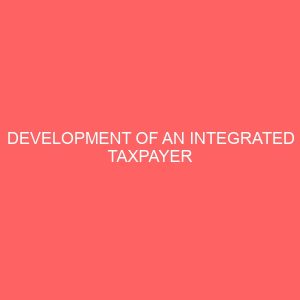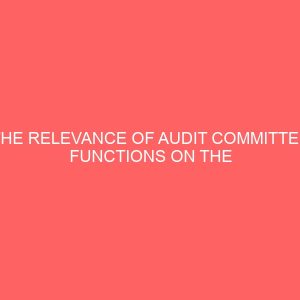Description
CHAPTER ONE
INTRODUCTION
This project is on Development of an integrated taxpayer identification number (tin) system. Computer – based tax identification number for taxpayers (TIN) is meant to address several areas of concern for the Internal Revenue Service, as well as third-party payer community. The third-party payer taxpayer group is primarily composed of members of the financial industry, such as banks, and credits unions, but also includes a multitude of other payers in the fields of life, property and health insurance, health care, telecommunications, federal, state and local governments.
In an effort to continue improving tax Administration in Nigeria the government through the tax Administration Reform Project (Tax ARP) implemented the taxpayer Registration system (TRS) to facilitate the registration and assignment of the unique taxpayer identification number (U-TIN). Tax identification number is a unique nine-digit identification number assigned to each individual taxpayer, business enterprise, organizations (non-profit, partnership, charity, etc) by way of an automated. It is issued either by the social security Administration (SSA) or by the Internal Revenue Service (IRS). A social security number (SSN) is issued by the social security administration whereas all other tax identification numbers are issued by the Internal Revenue Service.
Tax payer identification numbers includes; social security number (SSN), Employer Identification number (EIN), Individual tax-payer identification number (ITIN), and preparer taxpayer identification number (PTIN).
The most important benefits this computerized system will offer to FIRS includes; identification of each taxpaying entity by the use of a unique number, easy access to a reliable database and easy identification of the nature or type of businesses, geographical location and ownership.
1.1 BACKGROUND OF THE STUDY
The Nigeria Federal Inland Revenue was created in 1943 when it was carved out from the erstwhile Inland revenue Department and covered what was then Anglo-phone West Africa (including Ghana, Gambia and Sierra Leone) during the colonial era. In 1958, the Board of Inland revenue was established under the income tax ordinance of 1958. The name was later changed in 1961 when the Federal Board of Inland Revenue (FBIR) was established under section (4) of the Companies Income Tax Act (CITA) No.22 of 1961, FBIR operated then as a department in the federal ministry of finance. A further transformation of the FBIR took place in 1993 when the finance miscellaneous taxation provision Act No.3 of 1993 established the Federal Inland Revenue Service as the operational aim of FBIR. The Act also created the office of the executive chairman of the board.
In spite of these transformations, the Federal Inland Revenue Service still remained within the civil service system and government’s budgeting system. One of the major objectives of the current reforms is to obtain administrative and financial autonomy for the service.
1.2 OBJECTIVES OF THE STUDY
The objective of this project is to carry out a successful rollout and implementation of the taxpayer identification number (TIN) for Enugu State and the development of a related database linked to all relevant stakeholders in Enugu tax administration in order to bring Enugu State’s tax administration and practice in line with global best practices. It will also investigate and analyze the present problem encountered in the manual method of tax payment used by Federal Inland Revenue Service, Enugu branch. The new system will enhance the following:
- It will engender greater compliance in tax system because of its accuracy in capturing data of taxpayers.
- The system will reduce leakages in tax collection, eliminate corruption in tax system and enable tax authorities ascertain the actual income and taxes of all registered taxpayers.
- It will enhance taxpayer identification and registration thereby bringing/capturing more taxpayers into the tax net.
- Widening and deepening of taxpayer database.
- Due to its accuracy in the taxpayers’ database, the system will facilitate a more efficient system of tax assessment and collection as well as tax audit and investigation.
- The introduction of TIN program will reduce the existing loopholes in the tax system in Enugu State.
1.3 SIGNIFICANCE OF THE STUDY
This study will go a long to help the Federal Inland Revenue service, Enugu State branch to solve some of the problems encountered in manual registration system which is prone to a lot of errors and mistakes associated with manual registration. With effective and efficient TIN system in place, it will enhance ICT literacy and capacity building among the FIRS staff, provide basis for planning and budgeting purposes. It is likely that if this recommendations are not implemented there will be corruption in the tax system, and eligible tax payers will not pay their tax regularly when due. It will also block all leakages in tax collection, eliminate corruption in tax system and enable tax authorities to ascertain the actual income and taxes of all registered taxpayers.
Through this study, the author has gained a lot of knowledge and experience of which are not specified in the academic curriculum.
1.4 SCOPE OF THE STUDY
The scope of the study is limited to the tax activities of Federal Inland Revenue Service, Enugu State branch with focus on unique tax identification number for taxpayers which is concentrated on;
- Social security number (SSN)
- Individual taxpayer identification number (ITIN)
- Design and implementation of infrastructure and system to support TIN assignment to taxpayers.
- Development of a TIN format
- Set-up contact management centre (CMC) to support TIN program.
- Various software and hardware components which are necessary for the successful implementation the new system are also mentioned.
- Change management for successful phase roll-out.
1.5 LIMITATION OF THE STUDY
There are a lot of restraints faced by the writer before valuable information system was obtained for the production of this project. Among the problems includes;
- TIME: the time allocated to the project work is limited, that made the researcher unable to cover so many areas as should.
- FINANCE: the researcher, being a student was unable to afford all the financial responsibility involved in this study.
- They were not enough current textbooks, journals newspaper and difficulty in accessing the internet.
1.6 DEFINITION OF TERMS
- COMPUTER: It is an electromechanical device, that accepts inputs, process them, and relinquished the result at a fantastic speed.
- TIN: This is a taxpayer identification number that a payee is required to furnish to a payer. The TIN may be an employer identification number (EIN) a social security number (SSN) or an Individual taxpayer identification number (ITIN)
- TAX: According to web dictionary, tax is defined as a fee charged (levied) by the government on a product, income or activity.
- PARTICIPANT: Means a person that is either a payer, or a payer authorized agent and, that has applied and accepted to participate in the program.
- PRINCIPAL: Means a partner or an individual who owns at least five percent (5%) of the firm that is applying to participate in the TIN matching program.
- AUTHORIZED AGENT: Means a person or firm that, with the payer’s authorization transmits specific information return documents to the IRS on behalf of the firm and may match name/TIN combination on behalf of the payer. An ‘authorized agent” may assign/disable user access within their assigned location, update their location address information and perform TIN matching.
- TRANSMITTER: Means the federal agency sending in the magnetic tape cartridge containing the TINs for matching purpose.
- ACCOUNT: Means any account, instrument, contract, or other relationship with a payee with respect to which a payer is likely to make a reportable payment.
- DELEGATED USER: Means an individual who will utilize the TIN matching session options on behalf of the firm.
- PAYEE: A person to whom money is paid or is to be paid, especially, the person to whom a check is made payable.








Reviews
There are no reviews yet.